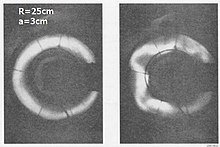
A kink instability (also known as a kink oscillation or kink mode) is a current-driven plasma instability characterized by transverse displacements of a plasma column's cross-section from its center of mass without any change in the characteristics of the plasma. It typically develops in a thin plasma column carrying a strong axial current which exceeds the KruskalâShafranov limit [1] [2] [3] and is sometimes known as the KruskalâShafranov (kink) instability, [4] [5] named after Martin David Kruskal and Vitaly Shafranov.
The kink instability was first widely explored in fusion power machines with Z-pinch configurations in the 1950s. [6] It is one of the common magnetohydrodynamic instability modes which can develop in a pinch plasma and is sometimes referred to as the mode. [6] (The other is the mode known as the sausage instability.)
If a "kink" begins to develop in a column the magnetic forces on the inside of the kink become larger than those on the outside, which leads to growth of the perturbation. [6] [7] As it develops at fixed areas in the plasma, kinks belong to the class of "absolute plasma instabilities", as opposed to convective processes.
References
- ^ Ryutov, D. D.; Furno, I.; Intrator, T. P.; Abbate, S.; Madziwa-Nussinov, T. (2006). "Phenomenological theory of the kink instability in a slender plasma column". Physics of Plasmas. 13 (3): 032105. Bibcode: 2006PhPl...13c2105R. doi: 10.1063/1.2180667. ISSN 1070-664X.
- ^ DeHaas, Timothy; Gekelman, Walter; Van Compernolle, Bart (2015). "Experimental study of a linear/non-linear flux rope". Physics of Plasmas. 22 (8): 082118. Bibcode: 2015PhPl...22h2118D. doi: 10.1063/1.4928888. ISSN 1070-664X.
- ^ Oz, E.; Myers, C. E.; Yamada, M.; Ji, H.; Kulsrud, R. M.; Xie, J. (2011). "Experimental verification of the Kruskal-Shafranov stability limit in line-tied partial-toroidal plasmas". Physics of Plasmas. 18 (10): 102107. Bibcode: 2011PhPl...18j2107O. doi: 10.1063/1.3647567. ISSN 1070-664X.
- ^ Cap, Ferdinand F. (2013-09-11). Handbook on Plasma Instabilities. Academic Press. ISBN 9781483271057.
- ^ Hasegawa, A. (2012-12-06). Plasma Instabilities and Nonlinear Effects. Springer Science & Business Media. ISBN 9783642659805.
- ^ a b c Zohuri, Bahman (2017-02-23). Magnetic Confinement Fusion Driven Thermonuclear Energy. Springer. pp. 46â48. ISBN 9783319511771.
- ^ Plasma Dictionary Archived 2006-09-29 at the Wayback Machine

A kink instability (also known as a kink oscillation or kink mode) is a current-driven plasma instability characterized by transverse displacements of a plasma column's cross-section from its center of mass without any change in the characteristics of the plasma. It typically develops in a thin plasma column carrying a strong axial current which exceeds the KruskalâShafranov limit [1] [2] [3] and is sometimes known as the KruskalâShafranov (kink) instability, [4] [5] named after Martin David Kruskal and Vitaly Shafranov.
The kink instability was first widely explored in fusion power machines with Z-pinch configurations in the 1950s. [6] It is one of the common magnetohydrodynamic instability modes which can develop in a pinch plasma and is sometimes referred to as the mode. [6] (The other is the mode known as the sausage instability.)
If a "kink" begins to develop in a column the magnetic forces on the inside of the kink become larger than those on the outside, which leads to growth of the perturbation. [6] [7] As it develops at fixed areas in the plasma, kinks belong to the class of "absolute plasma instabilities", as opposed to convective processes.
References
- ^ Ryutov, D. D.; Furno, I.; Intrator, T. P.; Abbate, S.; Madziwa-Nussinov, T. (2006). "Phenomenological theory of the kink instability in a slender plasma column". Physics of Plasmas. 13 (3): 032105. Bibcode: 2006PhPl...13c2105R. doi: 10.1063/1.2180667. ISSN 1070-664X.
- ^ DeHaas, Timothy; Gekelman, Walter; Van Compernolle, Bart (2015). "Experimental study of a linear/non-linear flux rope". Physics of Plasmas. 22 (8): 082118. Bibcode: 2015PhPl...22h2118D. doi: 10.1063/1.4928888. ISSN 1070-664X.
- ^ Oz, E.; Myers, C. E.; Yamada, M.; Ji, H.; Kulsrud, R. M.; Xie, J. (2011). "Experimental verification of the Kruskal-Shafranov stability limit in line-tied partial-toroidal plasmas". Physics of Plasmas. 18 (10): 102107. Bibcode: 2011PhPl...18j2107O. doi: 10.1063/1.3647567. ISSN 1070-664X.
- ^ Cap, Ferdinand F. (2013-09-11). Handbook on Plasma Instabilities. Academic Press. ISBN 9781483271057.
- ^ Hasegawa, A. (2012-12-06). Plasma Instabilities and Nonlinear Effects. Springer Science & Business Media. ISBN 9783642659805.
- ^ a b c Zohuri, Bahman (2017-02-23). Magnetic Confinement Fusion Driven Thermonuclear Energy. Springer. pp. 46â48. ISBN 9783319511771.
- ^ Plasma Dictionary Archived 2006-09-29 at the Wayback Machine

